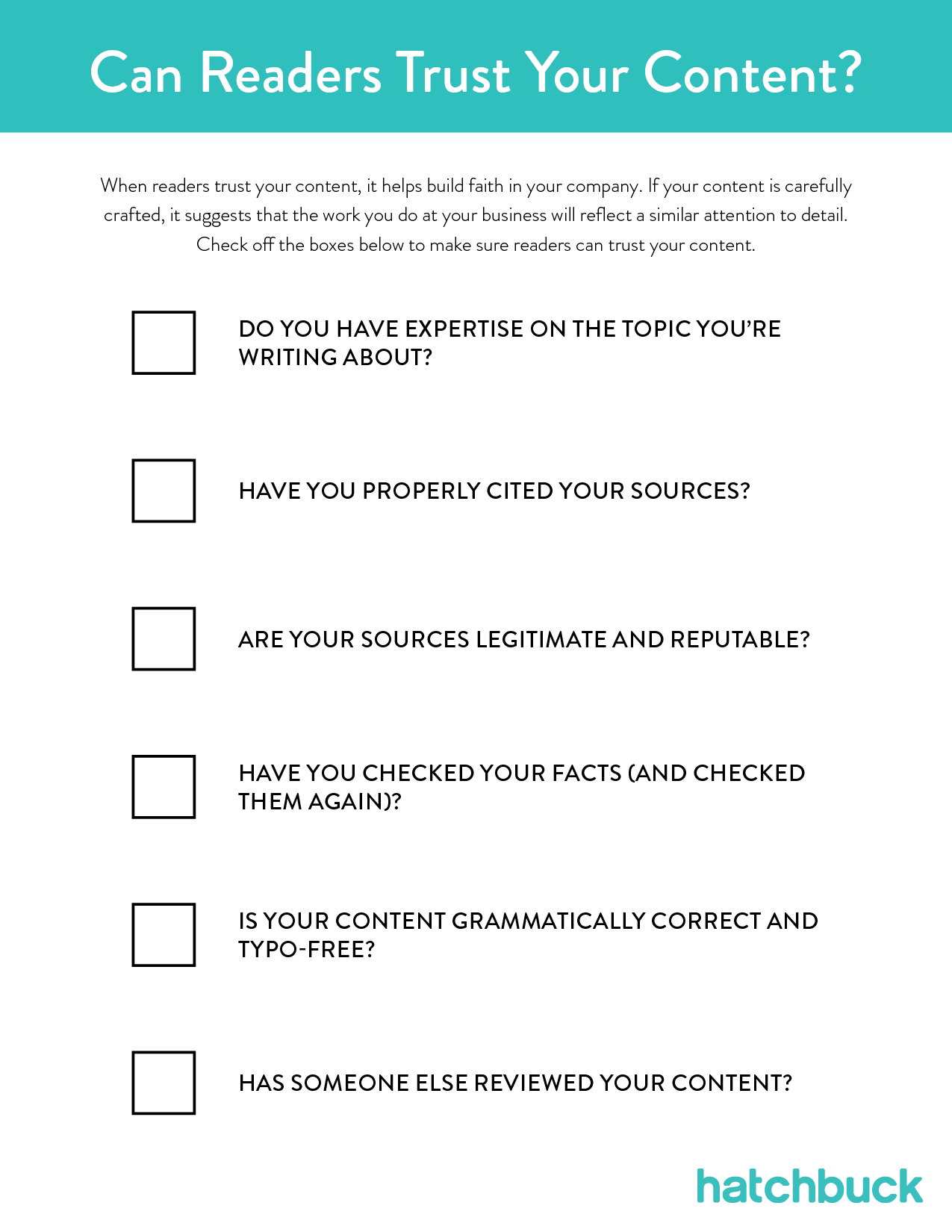With talk of “fake news” in the headlines constantly, it’s easy to get the jitters about publishing anything. Fortunately, if you publish credible, research-backed, trustworthy content, you have little to worry about. It’s hard for even the most mischievous internet troll to cast doubts on blogs, white papers or other material that is accurate, free from factual mistakes and supported by data that can be easily verified.
As you might imagine, creating credible content takes some work. It requires you to slow down long enough to double check what you’re publishing and proofread it carefully. But this is an insurance policy for your brand, similar to the quality control you perform for your product or service. When readers trust your content, it helps build faith in your company. If your content is carefully crafted, it suggests that the work you do at your business will reflect a similar attention to detail.
For a quick guide to trustworthy content, download our checklist below. Or read on for a deeper dive into why each checklist item is so important to master.
Write about what you know.
Readers can tell when you’re discussing something in which you have expertise or experience and they can especially tell when the topic is out of your element. This is why people often raise an eyebrow when they see Hollywood stars pontificating on complex political issues—unless these celebrities are actually well-versed in the subject through charitable work or direct personal experience.
Whether you’re writing a blog, a white paper or a marketing brochure, stick with what you truly know. Sharing genuine expertise in your writing will reinforce it in readers’ minds and allow them to treat your brand as an industry expert.
Cite information properly.
If you’re writing about news that’s being widely reported, such as the introduction of a major law that affects your clients, it’s not necessary to attribute it to a specific publication, TV station or radio show. But if you’re discussing a quote from a specific media interview or a unique detail a reporter uncovered, attribute it to the specific source. Doing so permits readers to make their own decision about whether that source is credible. They may have a different take on news that comes from, say, an unpaid blogging platform such as The Wall Street Journal or research published in the Harvard Business Review.
Only use sources you can verify.
Many statistics you’ve read in blogs are cribbed from other publications but never verified. One red flag is if you type a specific statistic mentioned into a search engine, you’ll find 15 blogs mentioning that fact—but none has a link to the original study. Another clue is that you can’t find the study in a quick search.
This casts doubt on the research methods of all of the sites that have mentioned the statistic. To avoid this problem in your own content, only include statistics you can personally verify—either because they came from unique data you gathered at your company or because there is a published study where you have actually seen the statistics with your own eyes. It shouldn’t take more than five or 10 minutes to uncover the original source and peruse the text to find the fact you plan to quote. If you can’t find it, don’t publish it. And if you do find it and have any doubts about the credibility or objectivity of the original source, don’t include it.
Fact check like a pro.
Publishing incorrect information can ruin your credibility with readers. Imagine how you would feel if your neighbor was profiled in the newspaper as Geoff Smyth—and he spells it Jeff Smith.
The good news is most factual mistakes are completely avoidable if you set aside time for fact checking. So how do you fact check? Double check any information that can be verified with outside sources, instead of relying on your memory. Use well-known online encyclopedias, such as Encyclopedia Britannica, and respected news publications to make sure you are mentioning the correct date an event occurred, for instance. If you mention a famous quote from a speech by Steve Jobs or another famous business leader, look up news accounts or the transcript online to make sure he really said it. And when you interview key customers to feature them in your blog or a case study, make sure you send them a quick list of facts to makes sure everything is accurate before you publish it.
Weed out typos.
Even if you don’t have someone who is a skillful copy editor on staff, it’s possible to root out most spelling and grammar errors from your copy if you use a three-pronged approach. First, run the copy through Grammarly, a free grammar checker. Then run it through your spell check. Finally, print it out and ask someone else on your team to read it, to spot any typos. If no one is available to help you, do this yourself. You’ll be surprised at how many typos you can catch by simply viewing the same text off screen.
Fix mistakes quickly.
No matter how careful you are, you may not catch every error. Correct any mistakes as quickly as you can. If a factual appears in a blog or other online publication, add a note explaining what has been corrected at the end, so readers who may have seen an older version are aware the article has been changed. No one likes to admit mistakes but doing so inspires trust—and will make sure readers trust your content in the long run.

